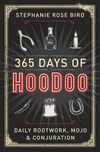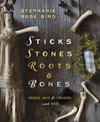Using Stones, Minerals, and Metals for a Charmed Life

Ashe
African shamans, warriors, hunters, and healers all employ the power of ashe to accomplish the task at hand. There is a venerable history that is not very prominent in general literature about the deft skill with which these specialized members of the community combine sticks, stones, roots, bones, and minerals to capture and direct power.
The names of these skilled professionals vary from culture to culture. The goal is to capitalize off the synergy generated from bringing together disparate parts together to create a single more powerful unit. The parts are usually organic, but minerals, stones, and metals are also combined with herbs, roots, and flowers to heal, protect, assure success, and attract prosperity. This article is an excerpt from my book, Sticks, Stones, Roots and Bones: Hoodoo Rootwork for a New Age. This article focuses on ways to harness the powers of the universe inherent in stone, metal, and minerals called ashe. My approach is historical and folkloric with practical applications. Remedies are treated as folklore and should never replace professional help. Since magic is drawn from within, I can give no guarantee concerning the efficacy of rituals or recipes presented. The missing ingredients are your personal powers, focus, and intent.
Minerals and stones play a very active role in African and African American healing traditions. In Daryl Cumber Dance's comprehensive book From My People: 400 Years of African American Folklore, she shares collected folklore stating that, to identify a Hoodoo or Conjurer, see if the person is carrying a beauty pebble (quartz crystal).
Stones seem to be inert, yet they are actually reservoirs of history, karma, and energy. Each type of stone has its own frequency and unique ability to aid the conjurer. First, though, the rock needs to be charged. There are several ways of charging a rock; most employ the elements:
- Bury rock and dig up, until the stone feels more powerful and clear
- Place stone under the sun from three days to one week
- Soak stone in saltwater, rainwater, lightning water, or sweet water
Hoodoo's assessment of the powers of particular stones is assigned by the color of the stone and the magical correspondence of the color. In this regard, Conjurers, Witches, and Wiccans share common ground when working stone or metal magic. So called "Voodoo Queen" Marie Laveau and her daughter Phoebie were the first prominent African American seers to employ the European-based tradition of lunar correspondences in their Hoodoo mojos.
Stones and their Magical Intent
- Green stones are believed to draw prosperity and, in some cases, health. These include peridots, jade, turquoise, malachite, and aventurine. Emeralds make a wonderful wedding stone.
- Yellow stones—citrine, amber, gold topaz (though a resin not a stone)—are thought to be uplifting, enlightening, empowering, energizing, and attractors because they are symbolic of the sun
- Pink stones—rose quartz, tourmaline, and rhondochrosite—are stones of the heart, friendship, and attraction
- Red stones—carnelian, ruby, garnet—are symbolic of life blood; they are cleansers, used for healing, birthing, protection, sexuality, and vitality
- Brown stones—smoky topaz, certain jaspers, tiger eye—are powerful possessors of animal spirit and magnetism, useful for grounding and centering
- Purple stones like amethyst are thought of as spiritual stones, and they are also used to generate peace or provide blessings.
- Clear stones—crystal or diamonds—are sacred stones capable of protection, healing, blessings, and many other purposes.
Stones with Special Features
- Sodalite: Improves health, aids sleep, clarifies sight
- Obsidian: focuses psychic intent, unhex, banishing negative, inner strength
- Hematite: Creativity, vitality, health; strengthens heart and blood
- Amethyst: Strength during transformation, weight loss, and overcoming addictions
- Fluorite: Helps institute "tough love" quality, loving detachment separations; surviving incarceration of a loved one; affects health of bones and teeth
- Multicolored, striated, and dense stones like onyx, agate, and jasper absorb negativity
- Fossils are some of the most sacred gifts of the Great Mother. Fossils are bones of sorts—remnants of ancient life. To charge them, hold them in your hands or put them on your altar. Fossils bring special energy to all of your work. You can also burn incense on top of a fossil.
- Amber: Amber is not a true rock; it is a resin. With its golden tone and sunny appearance, it is compared to Sun Ra. This resin often has insects trapped inside of it—giving us a brief glimpse at ancient life, frozen in time. Amber is always warm to the touch and is good for warming the sick; thus it enjoys a reach relationship with healers. An amber necklace is an important protective device when doing clearings and healing work.
- Pebbles and Rocks: You don't have to run out and spend a lot of money to use stones magically. In Jambalaya, author Luisah Teish reports having a collection of simple stones collected from around the world, that she keeps on her altar in a basket. Malidoma Patrice Some, author of The Healing Wisdom of Africa (Tarcher/Putnam NY), devotes a whole chapter to rocks and minerals. He is a member of the Dagara tribe, and he reports that he and his people believe that rocks and minerals are reservoirs of memory. Some recommends holding utilizing simple rocks and pebbles during memory or remembrance healing rituals.
Metallurgy for Conjur Craft
- Brass is widely used in Africa. The magical qualities of brass are similar to gold, without the implied vanity. Brass is a good metal for candleholders, for incorporation into the altar, and for love draw.
- Copper is a healing metal and a conduit of both spiritual and sexual energy. Copper is also associated with goddesses: Ishtar, Astarte, Inanna, and Isis. Copper coordinates well with quartz crystals. Copper-colored pennies are tossed in the home by Hoodoos as a charm for luck, salute to the ancestors, to draw luck and money. Trinidadians and other Black folk from the Caribbean and parts of South America are especially fond of copper bracelets and anklets as tools for healing bones. Copper is known to detoxify, stabilize, and deal with blood flow.
- Iron represents Ogun the warrior deity. Black folks in America have been cooking soul food in cast iron skillets for hundreds of years. Since iron is connected to Ogun, it carries some of protection into our food. Nails, rust, and metal filings are some ways that iron is used to conjure. Metalsmithing was an honorable traditional craft for Early African Americans. We continue to revere it and tap its magic.
- Lead Lead is used for its ability to hold and deliver intent. Lead pencils used to write in specific written jobs and tricks on brown paper (Kraft paper).
- Quicksilver was widely used for luck spells, but since it is actually mercury, it is extremely toxic. It is best to leave quicksilver to the hoodoo history books.
- Silver, to the African mind, represents the sea, great mothers of the moon. It is helpful for intuitive work, dream quest, fertility, and love tricks. Songhai wise men believe that the third finger of the left hand is our conduit of spirit power; therefore, a silver ring placed there enhances spirituality.
Hoodoo Horseshoe Folklore
The transformative aspect of metalsmithing and its ephemera led to a wealth of traditions within Hoodoo. Two of the objects steeped in the lore of metal smith are horseshoes and nails. The elaborate etiquette for the acquisition and magical use of horseshoes in hoodoo include:
- For a horseshoe to be lucky, the finder must pick it up and carry it with the prongs upwards
- It should also be hung with the U-shape at the bottom, prongs at the top
- Hanging the horseshoe properly allows it to become a vessel that holds luck
- Traditionally, horseshoes are hung outdoors on the property, a fence, or trees
When the horse was a primary form of transportation, you could walk around and find horseshoes. Horseshoes with the nails still intact were thought to be especially lucky.
Some practitioners would work with the nails themselves to draw good fortune, but for the most part it was considered unlucky to remove the nails.
Nails were also important binders both in a practical since (carpentry) and in a metaphysical one. It was believed that you could drive nails into someone's tracks at the heel to make them stay close to you. To keep a lover close by, his/her shoes were buried under the front step or porch and a simple pine plank was nailed on top to keep the lover at home. In short, nails are a binding tool that can lock your intentions. The ability of nails results from the magical way in which they were created.
Salt and Other Minerals
All life comes from the sea. We begin our lives as human fetuses submerged in amniotic fluid. The deities, orishas, gods, and goddesses of Ancient Lore vividly live out the importance of the sea.
According to Professor John Anenechukwa Umeh, author of After God is Dibla-Igbo Ceremony, Divination and Sacred Science (Karnak House, London England, 1999), salt is the solidified tears of God. God was so saddened by the spiritual and physical pollution that populates the earth that his worry and tears formed the great oceans and seas. Because salt is derived from the emotion of God, a combination of water and salt are used by Dibla (Igbo Wisemen/Healers) to clear all forms of negativity—even hatred.
From a feminine perspective, goddesses of many cultures play a key role in our conception of salt as being sacred; this may be because of the mystical quality of our formation within amniotic fluid. For example, the Water Jar is a symbol of Nut. Nut is of the sky—sun, moon, and stars. She is also mother to the gods. Her essence pours down rain from the heaven, thus assuring our fruitful harvest. She is the milk-giving cow goddess; goddess of the serpents of the primeval waters; fertile pig goddess; bird goddess and goddess of the underworld. Isis is the Great Mother Goddess of Ancient Egypt—the universe and humanities spring from her womb, nourished by her amniotic fluids.
Yemoya and Ologun are the great mothers of the Yoruban Ifa cosmology. The duo is considered compassionate and judicious—givers and takers of life. The two sea mothers represent the generosity of the universe.
Astarte of Mesopotamia is the light; guardian of ships; prayer goddess of the sea, moon, morning and evening stars. She is the cosmic womb and goddess of fertility. Venus is Aphrodite and Astarte's Roman counterpart. Her image has been condensed into the goddess of love, but essentially she is a great goddess of the sea—with all of the ramifications of the sea, including fertility, love, nurturing, cosmic womb, and the great mother.
Stones are plentiful, beautiful, and have a long history. The magical qualities of stones, minerals, and metals can be used alone or in combination with the elements to increase their ashe and efficacy.
Related Products


is subject to certain Terms and Conditions